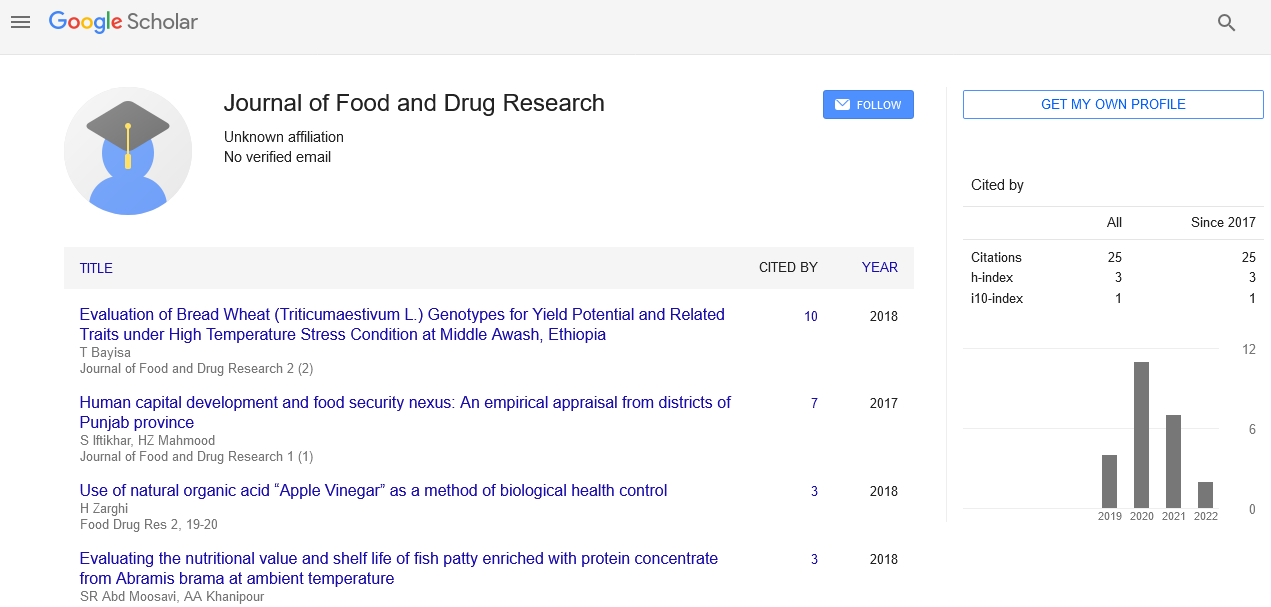A discussion about spices in relation to mycotoxin
Received: 12-Nov-2022, Manuscript No. PULJFDR-22-5737; Editor assigned: 14-Nov-2022, Pre QC No. PULJFDR-22-5737 (PQ); Accepted Date: Nov 27, 2022; Reviewed: 21-Nov-2022 QC No. PULJFDR-22-5737 (Q); Revised: 25-Nov-2022, Manuscript No. PULJFDR-22-5737 (R); Published: 30-Nov-2022, DOI: 10.37532/puljfdr.22.6(6).1-2
Citation: Rana K. A discussion about spices in relation to mycotoxin. J. Food Drug Res. 2022; 6(6):1-2.
This open-access article is distributed under the terms of the Creative Commons Attribution Non-Commercial License (CC BY-NC) (http://creativecommons.org/licenses/by-nc/4.0/), which permits reuse, distribution and reproduction of the article, provided that the original work is properly cited and the reuse is restricted to noncommercial purposes. For commercial reuse, contact reprints@pulsus.com
Abstract
Spices, like other food and agricultural products, are prized for their distinctive flavour. Additionally, they could add colour and enhance the food's overall quality of preservation. Spices and spice extracts are utilised in traditional remedies, cosmetics, and a variety of other purposes in addition to being employed in different native dishes and cuisines. Spices are susceptible to mould growth during harvest, processing, storage, and handling, which lead to the generation of secondary metabolites known as mycotoxins. Numerous abiotic elements, as well as the state of the spice, have a significant impact on both the rate of production and the degrees of contamination. Spices that have mycotoxin contamination are generally unsafe for human consumption. The main contributor to mycotoxin contamination in the spice supply chain is the poor implementation of scientific techniques. The FAO estimates that mycotoxins infect about 25% of all agricultural products worldwide. The main mycotoxins that contaminate spices are aflatoxins and ochratoxin. The review discusses the causes of mycotoxin contamination in spices, the consequences for health, the permissible limits in foods, and analytical techniques to identify mycotoxins.
Keywords
Spices; Traditional remedies; Abiotic elements; Human consumption; Secondary metabolites
Introduction
Spices are "any aromatic vegetable material in the whole, broken, Sor ground form that is used primarily to season food rather than to supply nutrients," according to the US Food and Drug Administration (FDA). Spices are employed frequently because of their distinctive flavour profile, therapeutic benefits, and colour, among other qualities. Additionally, they contain a lot of phytochemical components. Additionally, spices can be employed as preservatives. Spices can be extracted from various plant components and are sold as ground, whole, or processed goods. If necessary precautions are not implemented, every stage in the supply chain has the potential to impact spice quality and contribute to food safety issues. The quality of spices can be significantly impacted by improper procedures and working conditions during harvest, processing, storage, and handling. For instance, spices and spice goods are frequently stored using traditional methods of piling before being wrapped with jute bags, or other locally accessible materials, during periods of surplus production and during off-seasons. Traditional methods are frequently adopted for such applications, particularly in underdeveloped nations. Poorly maintained on-farm or indoor storage conditions cause considerable quality losses that are finally cause for concern due to an increase in fungal infection and insect infestation. In the majority of situations, there is a clear decline in visual quality, allowing for the first assessment of the product's quality. Increasing consumer concern over food safety and quality has made it more important than ever before to protect their health. Spices contaminated by fungi produce mycotoxin at temperatures between 25°C and 30°C, moisture concentrations above 16%, and a corresponding water activity of 0.70. Although it would take longer and result in lower quantities, mycotoxin formation is still possible at temperatures below 8°C –10°C. According to the European Spice Association (ESA), American Spice Trade Association (ASTA), and International Organization for Standardization, the majority of products classified as belonging to the spice family are extremely vulnerable to mycotoxin contamination (ISO). Food-borne infections are also brought on by spice contamination, which is also linked to illnesses and dysfunction syndromes, mostly affecting the digestive system. Therefore, it is unacceptable for even a little amount of contaminated spices to enter the food supply chain. Spices must be handled carefully and preserved in ideal circumstances in accordance with scientific management standards in order to avoid such repercussions. In the agrarian economies of the poor countries, spices are important. According to the value of their exports to other countries, key spice crops include black pepper, capsicum, nutmeg, cumin, cinnamon, ginger, turmeric, cloves, and coriander. In the years 2016 to 2017, 1.2 million hectares of land were used to produce 2.8 million tonnes of spices. Asia accounts for 95.1% of the world's total production of spices, followed by Africa (2.9%), America (1.5%), and Europe (0.5%). India is known as the "country of spices." Mycotoxins are ranked second among the top 10 food hazards and product categories from non-member nations in the RASFF annual report for the year 2017. In terms of mycotoxin contamination, nuts, nut products, and seeds are the most vulnerable, although herbs and spices are second only to fruits and vegetables in ca. Mycotoxins differ in their chemical composition and metabolic processes. Regarding species, variations are also obvious. Age, sex, health status, and dietary habits are other relevant variables. Undoubtedly, AFs are the subject of the majority of studies on mycotoxin toxicity, and this pattern is also seen in studies that describe the metabolic routes of mycotoxins.






